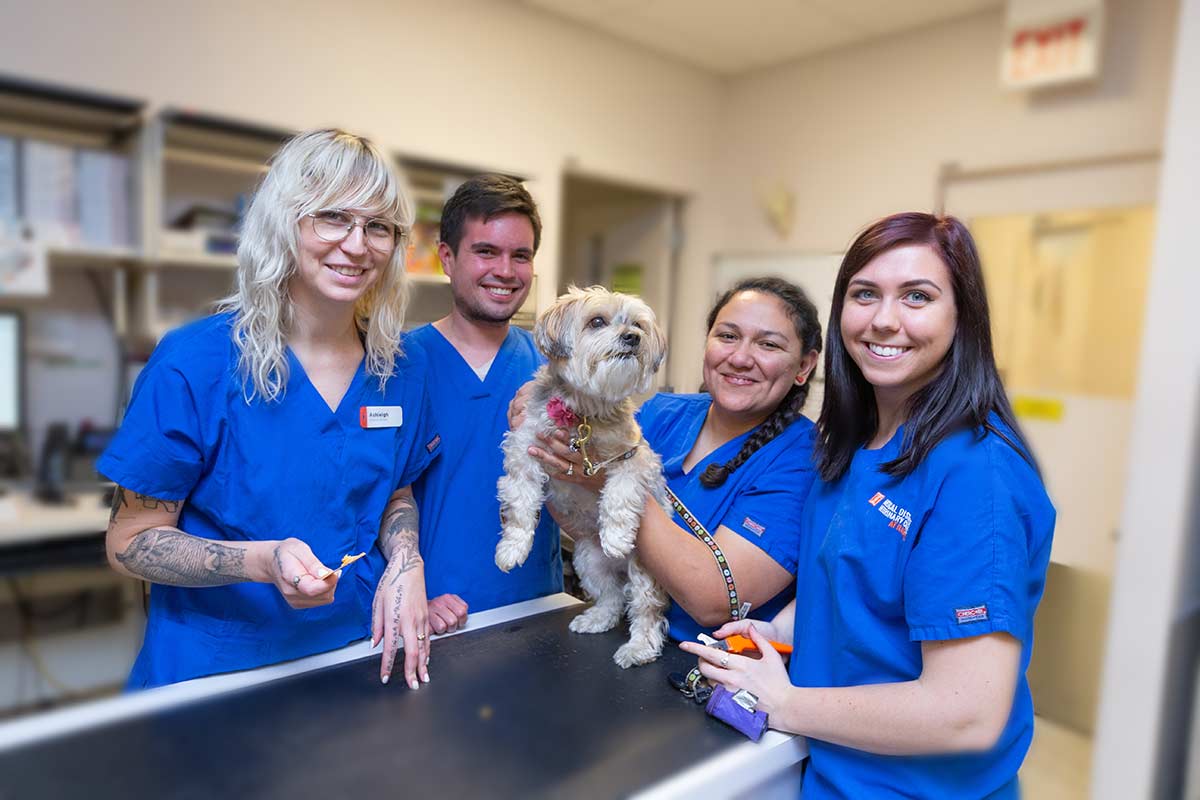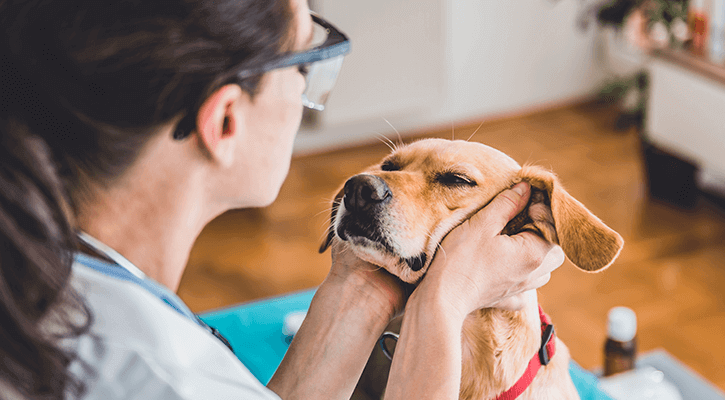Why Animal Rehabilitation Is Vital: the Perks of Vet Solutions for Your Pet's Recuperation
Animal rehabilitation is a necessary element of recuperation for family pets encountering injuries or handicaps. Veterinary services offer vital assistance through tailored recovery strategies that address individual needs. These plans commonly include pain management, physical therapy, and dietary support. Understanding the various facets of animal rehab can brighten its value in enhancing recuperation outcomes. What certain benefits do these solutions supply, and how can they transform a pet's healing journey?
Comprehending Pet Rehabilitation
Animal recovery incorporates a variety of restorative practices targeted at restoring the health and functionality of hurt or impaired pets. This area integrates various methods, including physical treatment, hydrotherapy, and work treatment, tailored to satisfy the certain requirements of each animal. Rehabilitation specialists evaluate a pet's problem, establishing individualized treatment plans that might involve workouts to reinforce muscles, improve mobility, and enhance overall well-being. The process not only concentrates on physical recuperation yet likewise addresses psychological and behavioral elements. Animals usually experience stress and anxiety and stress and anxiety adhering to an injury, making mental wellness factors to consider essential in recovery. By creating an encouraging setting, specialists can aid animals restore their confidence and adapt to their new circumstances. With routine sessions, animals can experience considerable renovations, eventually leading to a better top quality of life. On the whole, recognizing pet rehab highlights its importance in promoting healing and boosting the bond between family pets and their owners.
The Duty of Pain Management in Healing
Just how vital works pain monitoring in the recovery of damaged pets? It plays a vital role in facilitating healing and improving the total wellness of family pets. Proper pain monitoring not only reduces discomfort however additionally advertises mobility, making it possible for pets to join rehab activities essential for healing. When pain is effectively taken care of, pets tend to respond positively to therapy, leading to quicker rehab outcomes.Veterinarians utilize different methods to assess and resolve discomfort, including drugs, acupuncture, and alternate therapies. By tailoring discomfort monitoring methods to the specific demands of each pet, vets can assure that family pets remain calm and participating throughout their recovery journey. Additionally, lessening pain helps in reducing stress, which can prevent healing and extend recuperation times. To summarize, reliable pain management is crucial for boosting the healing procedure and improving the lifestyle for hurt pets.
Physical Treatment Methods for Pet Dogs
Many physical therapy techniques are readily available to aid in the recovery of pet dogs recovering from injuries or surgical treatments (canine tplo surgery). These strategies can enhance wheelchair, alleviate pain, and advertise healing. Healing workouts, for example, aid reinforce muscular tissues and improve joint function, permitting pets to reclaim their physical capacities progressively. Hand-operated therapy, which includes massage therapy and mobilization, can alleviate tension and improve circulation, adding to a quicker recovery.Other techniques such as easy array of movement exercises encourage joint versatility and minimize stiffness. Furthermore, electric stimulation treatment might be used to stimulate nerves and muscle mass, advertising healing and discomfort relief.Veterinary professionals usually tailor these techniques to each animal's certain needs, guaranteeing an extensive rehabilitation plan. By executing these physical therapy techniques, family pets can experience better lifestyle and a much more successful healing from their conditions. The assimilation of these techniques into rehab programs is essential for excellent healing outcomes
Advantages of Hydrotherapy for Rehabilitation
Hydrotherapy provides considerable benefits in pet recovery, particularly in enhancing mobility. This water-based therapy advertises discomfort alleviation while offering comfort to harmed or recuperating pets. Additionally, it assists in strength-building exercises that add to general physical recuperation.
Improved Movement Improvement
As animals recoup from injuries or surgical procedures, enhanced flexibility often becomes a main goal of their recovery. Hydrotherapy functions as a useful tool in accomplishing this objective. Via water-based exercises, pets can participate in low-impact activities that assist in joint wheelchair and strengthen muscular tissues without the anxiety of weight-bearing tasks. The buoyancy of water supports their bodies, enabling for enhanced variety of activity and movement improvement. Additionally, hydrotherapy encourages much better equilibrium and coordination, which are crucial for restoring normal motion patterns. Normal sessions can bring about significant development in a pet's physical capabilities, ultimately improving their quality of life. This method not just help in recuperation however additionally advertises a much more energetic and meeting way of life post-rehabilitation.
Pain Alleviation and Convenience

Alleviation from discomfort is an essential element of pet rehabilitation, and hydrotherapy considerably adds to this process. By using water's buoyancy, hydrotherapy reduces joint stress and eases pain throughout activity. This therapeutic method provides a relaxing atmosphere where family pets can participate in mild exercises without the full weight of their bodies impacting their healing. The warm water boosts blood circulation, promoting recovery while additionally encouraging relaxation. Furthermore, hydrotherapy sessions can be customized to fulfill the particular demands of the animal, making certain ideal convenience. As animals experience minimized discomfort and raised comfort levels, their overall willingness to participate in recovery activities commonly enhances, bring about an extra efficient healing trip. Hydrotherapy serves as a crucial device in improving pain relief and comfort during recovery.
Stamina Structure Exercises
Strength-building workouts play an essential role in the recovery procedure, with hydrotherapy offering distinct advantages. This kind of therapy makes use of water resistance to boost muscular tissue toughness without placing too much pressure on the joints. The buoyancy of water supports the pet dog's weight, enabling much safer activity and boosted range of movement. In addition, hydrotherapy can enhance cardio wellness and promote overall physical fitness, assisting in faster recovery from injuries or surgical procedures. The controlled environment likewise reduces the danger of reinjury, making it an ideal alternative for pet dogs calling for rehabilitation. Routine hydrotherapy sessions can bring about visible improvements in mobility, stamina, and endurance, ultimately improving the pet dog's quality of life and capacity to return to typical activities.
Significance of Personalized Rehabilitation Plans
Personalized rehabilitation plans are important for addressing the unique demands of each animal, making certain individualized therapy approaches. These plans here enable for efficient development tracking and required changes, cultivating perfect recuperation end results. Furthermore, an alternative strategy can boost the total wellness of the animal, promoting a much more extensive recovery experience.
Individualized Treatment Approaches
While numerous rehab programs embrace a one-size-fits-all approach, the one-of-a-kind needs of each pet necessitate customized treatment prepare for perfect recuperation. Customized rehab plans take right into account various aspects, consisting of the pet's varieties, age, case history, and certain injuries or conditions. By tailoring interventions, vets can address each pet dog's distinct difficulties, maximizing the efficiency of the recovery process. Individualized plans may integrate different techniques such as physical therapy, hydrotherapy, and restorative exercises, ensuring that the therapy straightens with the pet's capabilities and progression. Additionally, personalized methods cultivate a more powerful bond in between the animal and the caretaker, advertising a more interesting and encouraging recovery setting. Inevitably, personalized therapy is necessary for achieving best feasible end results in pet rehabilitation.
Progression Monitoring and Adjustments

Holistic Recovery Strategies
Alternative healing strategies are essential for efficient animal recovery, as they emphasize the importance of personalized treatment plans customized to each pet's specific requirements. This technique takes into consideration the physical, psychological, and environmental aspects affecting recovery. Custom-made rehab plans might include a combination of physical therapy, dietary therapy, and behavior alterations. By attending to these diverse elements, vets can enhance the general well-being of the pet and promote a faster recuperation. Furthermore, such customized techniques help with a much deeper understanding of the family pet's distinct difficulties, bring about a lot more efficient interventions. Ultimately, all natural healing strategies not only boost physical health and wellness however also contribute to the pet's psychological and emotional security, ensuring an extensive recovery experience.
The Influence of Nutrition on Healing
Nutrition plays a crucial duty in the recovery procedure for refurbishing animals, usually figuring out the rate and performance of recovery. A healthy diet plan gives the required nutrients that sustain tissue fixing, boost the body immune system, and boost general vitality. Healthy protein is especially essential, as it assists in muscle mass restoring and recovery from injuries. Crucial fats, vitamins, and minerals likewise add to lowering swelling and promoting optimal cellular function.Veterinarians regularly emphasize the relevance of tailored nutrition plans, thinking about each animal's specific requirements, age, and health and wellness standing. Appropriate hydration is just as vital, as liquids facilitate vitamins and mineral absorption and aid in cleansing. By making certain that family pets receive appropriate nourishment, caregivers can substantially enhance their opportunities of a successful recovery, causing much better long-term wellness results. Eventually, nutrition works as a fundamental aspect in the recovery trip, supporting pets in gaining back strength and strength post-injury or ailment.
Success Stories: Animals Who Thrived After Rehab
Effective rehabilitation stories are plentiful, showcasing the durability of animals who have actually gotten over considerable challenges. Take, for circumstances, Bella, a golden retriever that experienced serious injuries from a cars and truck crash. With dedicated vet treatment and a comprehensive recovery program, she regained her mobility and went back to her playful self, much to her owner's delight. Similarly, Max, a senior cat identified with joint inflammation, experienced impressive renovation via a combination of physical therapy and discomfort management. His newfound agility enabled him to appreciate his favored sunbathing spots once again. One more motivating case is that of Coco, a rescued greyhound who conquered stress and anxiety via behavior adjustment and socialization techniques, allowing her to grow in her brand-new home. These success stories exemplify the transformative power of pet recovery, emphasizing that with the right support, pet dogs can not only recuperate however lead meeting lives, improving the bonds they share with their households.
Often Asked Questions
How Long Does the Recovery Process Usually Take for Pets?
The recovery process for pet dogs normally varies based upon the injury or problem, ranging from a couple of weeks to a number of months. Specific progression, treatment type, and dedication to workouts greatly affect the general duration of recuperation.
Are There Any Type Of Risks Connected With Pet Rehab?
Animal recovery might carry threats such as worsening of injuries, incorrect methods causing discomfort, or not enough monitoring during recuperation. These factors can prevent progression and impact the overall performance of the rehab process.

Can All Pets Take Advantage Of Recovery Solutions?
Not all pets might need rehabilitation, however many can benefit greatly. Rehab solutions can improve wheelchair, alleviate discomfort, and boost overall wellness, specifically for those recouping from injuries, surgeries, or persistent conditions.
Just How Can I Prepare My Family Pet for Rehab Procedure?

What Indications Suggest My Pet Demands Recovery?
Indications showing a pet may need rehab include problem strolling, hopping, decreased activity levels, unwillingness to leap, or indicators of discomfort. Observing these actions can prompt owners to look for professional analysis and treatment for their animals.